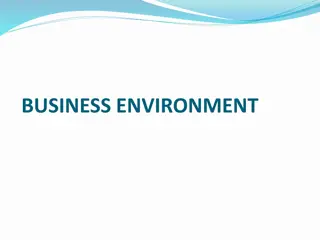Understanding the Business Environment and its Impact on Education
The business environment encompasses all external and internal factors that influence a business. It is dynamic, multi-faceted, and requires adaptability for survival. Businesses interact closely with the environment, with limited capacity to influence it. The components of the internal environment include organizational goals, resources, and human capital. External factors, both micro and macro, such as political, economic, and social elements, also play a crucial role. Additionally, the educational environment in India is closely linked to the business sector, with business supporting educational activities for human capital development. Education, in turn, contributes to business growth and professionalism.
Download Presentation

Please find below an Image/Link to download the presentation.
The content on the website is provided AS IS for your information and personal use only. It may not be sold, licensed, or shared on other websites without obtaining consent from the author. Download presentation by click this link. If you encounter any issues during the download, it is possible that the publisher has removed the file from their server.
E N D
Presentation Transcript
Definition of Business Environment According to Davis, Keith: Environment of a business means the aggregate of all conditions, events and influences that surround and affect it. Main Features/ Nature of Business Environment:- Environment is the surrounding situation Environment is multi-faceted and dynamic It has a far reaching impact on business It needs adaptability Two broad components Environment is complex and uncertain
Inter- Relationship between Business and Environment Closely related concepts Business has limited capacity to influence environment Continuous interaction with environment Integrated approach to business environment is a must for survival
BUSINESS ENVIRONMENT EXTERNAL INTERNAL
COMPONENTS OF INTERNAL ENVIRONMENT Goals of the organization Value based management Corporate image Physical and Financial resources Human Resources Labour Relations R&D facilities Strong Financial Base
EXTERNAL ENVIRONMENT MICRO MACRO
Components of Micro Environment Corporate Resources Suppliers Customers Middlemen Competitors Society
Components of Macro Environment Political Economic Social and Cultural Technological Legal Ecological/ Natural Demographic International Ethical
Educational Environment Educational Environment is the economic surrounding or situation within which the education , training and manpower development activities are undertaken. It is the education system which creates human capital. Features of educational environment in India Influencing factors 2. Close connection with business 3. Business supports education 4. Position of educational environment in India 1.
Impact of Education on Business Growth of Professionalism in business 1. 2. Change in attitude 3. Inflow of social skills in business 4. Trained leadership in business sector 5. Creativity and innovation in business 6. Ensures optimum utilization of resources in business
Measures to improve standards in education Management Courses- high calibre Sponsored educational institutions Privatization and globalization in higher education Use of modern techniques Training to teachers Industry and Academics Quality education
Measures to improve education environment in India Expenditure to be raised Adequate opportunities Literacy rate to be increased Funds for research Quality education Autonomy Vocational education and Skill development
INTERNATIONAL ENVIRONMENT Very important component of business environment Result of international events which include political and economic Factors and forces which are global in nature
World Trade Organization (WTO) Started functioning from 1st January, 1995 Result of Uruguay round of negotiations Successor of GATT India is one of the founder members of WTO WTO has 160 countries as its members Based at Geneva, Switzerland
Objectives of WTO Free trade i.e. trade without discrimination Growth of less developed countries Protection and preservation of environment Raising the standard of living of citizens of its member countries Creation of full employment situation Settlement of trade disputes among member countries Adopts the principle of sustainable development
TRADING BLOCS Formation of group of countries for mutual benefits Some Trading Blocs are:- European Union 2. Formed to make rapid progress in European countries 3. It is the most powerful as well as progressive and successful trading bloc in the world 1.
NAFTA North American Free Trade Agreement USA, Canada and Mexico Came into operation in 1994 Objectives of NAFTA:- More and easy access to financial services 2. To develop social and cultural relations 3. To develop industrial growth 4. Lowering trade barriers 1.
SAARC- South Asian Nations for Regional Co-operation Association of south Asian countries 8 countries are the members of SAARC India is also one of the member Objectives of SAARC To develop cooperation among the member countries To promote economic and social development To strengthen the relationship and cooperation among these countries To promote the welfare of the people of these countries 1. 2. 3. 4.























